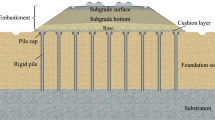Abstract
Piles in a composite foundation share loads with the surrounding soil instead of carrying all loads alone as a pile foundation. Stress concentration ratio, defined as the ratio of the stress on the top of piles to the stress on the surrounding soil, is essential for the design of piles in the composite foundation. An equal strain condition is widely accepted and adopted in the existing methods of calculating the stress concentration ratio. In other words, the piles should have identical relative displacement with the surrounding soil in an equal strain condition. This assumption may work for flexible and semi-rigid piles; however, it may not be suitable for rigid piles considering the significant stiffness difference of pile and soil. The relative displacement of rigid piles and surrounding soil can significantly change the stress distribution on piles and soils due to the pile-soil interaction (i.e., pile side friction). Therefore, the pile-soil interaction should be considered in the design of the rigid piles in the composite foundation. In this study, a simplified theoretical solution of the stress concentration ratio was derived based on the deformation coordination between rigid pile and soil to consider the pile-soil relative displacement and thus the pile-soil interaction. The pile side friction was assumed as linearly increased with the pile-soil relative displacement and then the stress concentration ratio was derived based on the force and deformation equilibrium in the composite foundation. A neutral point (i.e., location with zero pile-soil relative displacement) was included in the derivation to take the negative skin friction along the pile into account. Lab-scale and full-scale field tests were conducted to verify the effectiveness of the proposed method. Comparison of measured stress concentration ratios with calculated ones using the proposed method demonstrates the effectiveness of the proposed method.
Similar content being viewed by others
References
Abusharar, S. W., Zheng, J. J., Chen, B. G., and Yin, J. H. (2009). “A simplified method for analysis of apiled embankment reinforced with geosynthetics.” Geotextileand Geomembranes, Vol. 27, No. 1, pp. 39–52, DOI: 10.1016/j.geotexmem.2008.05.002.
British Standard (1995). Code of practice for strengthened/reinforced soils and other fills, BS 8006, British Standard Institution, London, 162. DOI: 10.3403/30093259U.
Castro, J. and Sagaseta, C. (2011). “Consolidation and deformation around stone columns: Numerical evaluation of analytical solutions.” Computers and Geotechnics, Vol. 38, No. 3, pp. 354–362, DOI: 10.1016/j.compgeo.2010.12.006.
Chen, Y. M., Cao, W. P., and Chen, R. P. (2008). “An experimental investigation of soil arching within basal reinforced piled embankments.” Geotextiles and Geomembranes, Vol. 26, pp. 164–174, DOI: 10.1016/j.geotexmem.2007.05.004.
Gangakhedar, R. (2004). Geosynthetic reinforced pile-supported embankments, Master thesis, University of Florida, DOI: 10.1680/jgein.15.00038.
Han, J. (2012). “Recent advances in column technologies to improve soft soils.” Invited keynote lecture, Proceedings of International Conference on Ground Improvement and Ground Control, Vol. 1, B. Indraratna, C. Rujikiatkamjorn, and J. Vinod (eds.), Wollongong, Australia, 30 October to 2 November, Research Publishing, Singapore 99–113, DOI: 10.3850/978–981–07–3559-3_101–0004.
Han, J. (2015). Principles and Practice of Ground improvement, John Wiley and Sons, Hoboken, New Jersey, DOI: 10.13140/RG.2.1.
Han, J. and Gabr, M. A. (2002). “A numerical study of load transfer mechanisms in geosynthetic reinforced and pile supported embankments over soft soil.” J. Geotech. Geoenviron. Eng., Vol. 128, No. 1, pp. 44–53, DOI: 10.1061/(ASCE)GT.1943-5606.0000561.
Han, J. and Ye, S. L. (2001). “A simplified method for computing consolidation rate of stone column reinforced foundations.” Journal of Geotechnical and Geoenvironmental Engineering, Vol. 127, No. 7, pp. 597–603, DOI: 10.1061/(ASCE)1090-0241(2001)127:7(597).
Hewlett, W. J. and Randolph, M. F. (1988). “Analysis of piled embankments.” Ground Engineering, Vol. 21, No. 3, pp. 12–18.
Huang, J., Han, J., and Collin, J. G. (2006). “Deformations of geosyntheticreinforced column-supported embankments.” Proc., 8th Int. Geosynthetics Conf., International Geosynthetics Society, Yokohama, Japan, pp. 1029–1032, DOI: 10.1680/gein.14.00010.
Kempfert, H. G., Gobel, C., Alexiew, D., Heitz, C. (2004). “German recommendations forreinforced embankments on pile-similar elements.” In: EuroGeo3-third European Geosynthetics Conference, Geotechnical Engineering Withgeosynthetics, pp. 279–284, DOI: 10.1007/978-3-540-69313-0_128.
Love, J. and Milligan, G. (2003). “Design methods for basally reinforced pile-supported embankments over soft ground.” Ground Engineering, Vol. 36, No. 3, March, 39–43, DOI: 10.1007/978-3-540-69313-0_129.
Low, B. K., Tang, S. K., and Choa, V. (1994). “Arching in piled embankment.” Journal of Geotechnical Engineering, ASCE, Vol. 120, No. 11, pp. 1917–1938, DOI: 10.1061/(ASCE)0733-9410(1994) 120:11(1917).
Lv, W. H. and Miao, L. C. (2015). “A simplified 2-D evaluation method of arching effect for geosynthetic-reinforced and pile-supported embankment.” Computer and Geotechnics, Vol. 65, No. 1, pp. 97–103, DOI: 10.1016/j.compgeo.2014.11.014.
Maddison, J. D., Jones, D. B., Bell, A. L., and Jenner, C. G. (1996). “Design and performance of an embankment supported using low strength geogrids and vibroconcrete columns.” Proceedings, Geosynthetics: Applications, Design and Construction, De Groot, Den Hoedt, and Termaat (eds), pp. 325–332.
Miao, L., Wang, F., Zhang, Y., and Zhang, C. (2009). “Experimental study on controlled modulus column methods.” Proc. of US-China Workshop on Ground Improvement Technologies (GSP 188), Han, J., Zheng, G., Schaefer, V. R., and Huang, M. S. eds., Mar. 14, 2009, Orlando, FL, pp. 112–119, DOI: 10.1061/41025(338)12.
Miao, L., Wang, F., Han, J., and Lv, W. (2014). “Benefits of geosynthetic reinforcement in widening of embankments subjected to foundation differential settlement.” Geosynthetics International, Vol. 21, No. 5, pp. 321–332.
Suleiman, M., Pham, H., and White, D. (2003). Numerical analyses of geosynthetic-reinforced rammed aggregate pier-supported embankments, Report No. ISU-ERI-03598, Department of Civil, Construction and Environmental Engineering, Iowa State University, DOI: 10.1061/40744(154)52.
Terzaghi, K. (1943). Theoretical Soil Mechanics, John Wiley and Sons, New York, pp. 66–76, DOI: 10.1002/9780470172766.
Author information
Authors and Affiliations
Corresponding author
Rights and permissions
About this article
Cite this article
Miao, L., Wang, F. & Lv, W. A Simplified Calculation Method for Stress Concentration Ratio of Composite Foundation with Rigid Piles. KSCE J Civ Eng 22, 3263–3270 (2018). https://doi.org/10.1007/s12205-018-1558-5
Received:
Revised:
Accepted:
Published:
Issue Date:
DOI: https://doi.org/10.1007/s12205-018-1558-5




